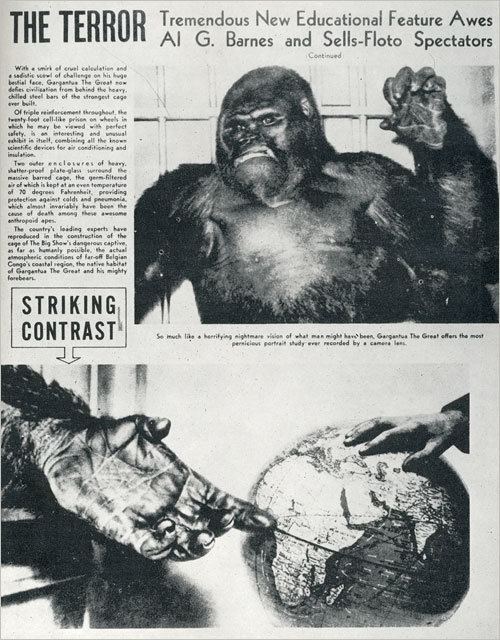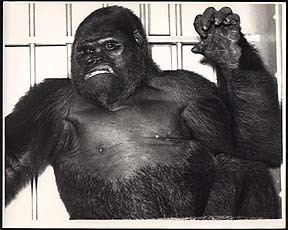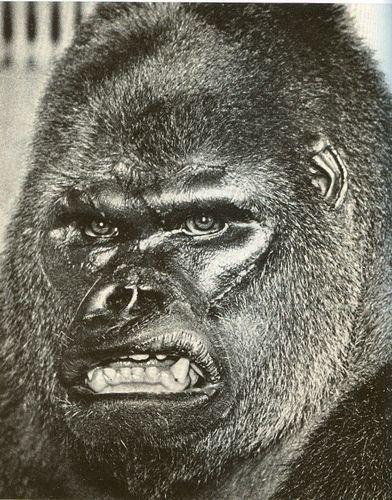Died November 1949 | Weight 270 kg | |
 | ||
Gargantua (1929 - November 1949) was a captive lowland gorilla who was famous in his lifetime and has been credited with saving the Ringling Brothers circus from bankruptcy. An acid scar on his face gave Gargantua a snarling, menacing expression, and the circus management attracted attention to him by emphasizing, in their publicity, his alleged hatred of humans. He was also claimed to be the largest gorilla in captivity.
Contents
Gargantua was captured as a baby in Africa, and was known as "Buddy" for years. After he was sold to Ringling Brothers by his previous owner, Gertrude Lintz, he was renamed, after François Rabelais's the giant character, to sound more frightening.

He had a "mate" named Toto, but apparently never showed any interest in her. She was nevertheless advertised by the circus as "Mrs Gargantua".

The film Buddy, starring Rene Russo, is very loosely based on the early life of Gargantua/Buddy and another of Mrs Lintz's gorillas, Massa.

Early life of Gargantua

Gargantua was born wild in the Belgian Congo in approximately 1929. In the early 1930s, the gorilla was given to a Captain Arthur Phillips as a gift from missionaries in Africa. The captain was fond of him and called him "Buddy". He was kept aboard his freighter and became popular with most of the crew. One sailor, however, drunk and seeking revenge on the captain's strictness, threw nitric acid in Buddy's face. This did not kill the gorilla but the attack almost blinded him and left both mental and physical scars - leading to much more aggressive behaviour.
Unable to deal with this aggression, the captain gave Buddy to Gertrude Lintz, a wealthy eccentric who looked after sick animals in Brooklyn. Her husband, Dr Bill Lintz, diagnosed Buddy with double pneumonia. Mrs Lintz treated the little gorilla back to health, including chewing his food for him, and along with her kennel-man, Richard "Dick" Kroener, trained and raised Buddy. She cared for Buddy, and other apes, as her children and even arranged for plastic surgery on the scar, leaving Buddy with a permanent sneer. She was known to drive around Brooklyn with Buddy, dressed in clothes, in the passenger seat. The arrangement came to an end one night in 1937 when the 460 lb (210 kg) Buddy, frightened by thunder, broke out of his cage and climbed into bed with his "mother" for comfort; Mrs Lintz contacted John Ringling shortly thereafter.
Circus attraction
Ringling bought Buddy from Mr Lintz (for less than $10,000) and renamed him "Gargantua" at his wife's suggestion. The Ringling Bros. and Barnum & Bailey Circus, in financial problems after the Great Depression, heavily advertised their newest attraction. Their extravagant claims included:
Regardless of the truth of these slogans, Gargantua attracted millions and single-handedly saved the circus.
A special cage was built for Gargantua by The Crane Company. It was air-tight and air conditioned, designed to keep Gargantua in and the spectators' diseases out.
His first public appearance was in April 1938 and was recorded by Time magazine:
Appearing as Display No. 14 on the 26-item program, Gargantua was hauled round & round the Garden in a heavily barred, thickly glassed, air-conditioned wagon drawn by six white horses. Stocky & truculent, he stared menacingly out of his cage, was characterized by Frank Buck as "the most ferocious, most terrifying and most dangerous of all living creatures."
Gargantua stole the show.
Gargantua's supposed aggression and violence were emphasized in the Circus' publicity. For example, Time magazine also wrote this earlier in the same year:
"Gargantua the Great, wrote Gargantuan Columnist Heywood Broun three weeks ago, "is the fiercest looking thing I have ever seen on two legs. And probably his power and truculence were all the more impressive because he did look a good deal like a distant relative. No one was allowed to go close to his cage, because Gargantua can reach about five feet through the bars and get a toe hold on a visitor whom he dislikes." Gargantua may not be the world's biggest captive gorilla—since the death of Berlin Zoo's monster, many zoos have claimed that honor for their gorillas—but he is one of the most vindictive. Last week the circus' executive vice president, young John Ringling North, nephew of the late John ("Three-Ring") Ringling, was inspecting the circus' Sarasota, Fla. winter quarters. Imprudently disregarding warning signs, he leaned against the bars of Gargantua's cage to rest. Gargantua reached through, got no toe hold but wrenched Circusman North's left arm into the cage, bit & wrung it until Trainer Richard Kroner, pounding the gorilla with an iron stake, distracted its slow attention.
In 1941, he was paired with another gorilla, Toto (short for Mitoto or M'Toto), who was advertised as "Mrs Gargantua". Nothing ever came of the relationship, however, and both lived in separate cages. In May 1942, his trainer since babyhood, Richard Kroener, died. As Kroeners' assistant Julius Gerlick had just been drafted, this left Gargantua to be trained by strangers.
Death
Gargantua died in November 1949 of double pneumonia. A necropsy performed at Johns Hopkins Hospital revealed that Gargantua had been suffering from several conditions at the time of his death, including skin disease and four impacted and rotten wisdom teeth.
His skeleton was donated to the Peabody Museum in 1950, but it is now only displayed on special occasions.
Physical characteristics
Sources report Gargantua's weight variously as 550 lb (250 kg)-600 lb (270 kg). The seven-year-old Gargantua was described as 460 lb (210 kg) when first displayed. His standing height was said to be 1.68 m (5 ft 6 in). Lowland Gorillas usually only reach 440 lb (200 kg) in the wild.
